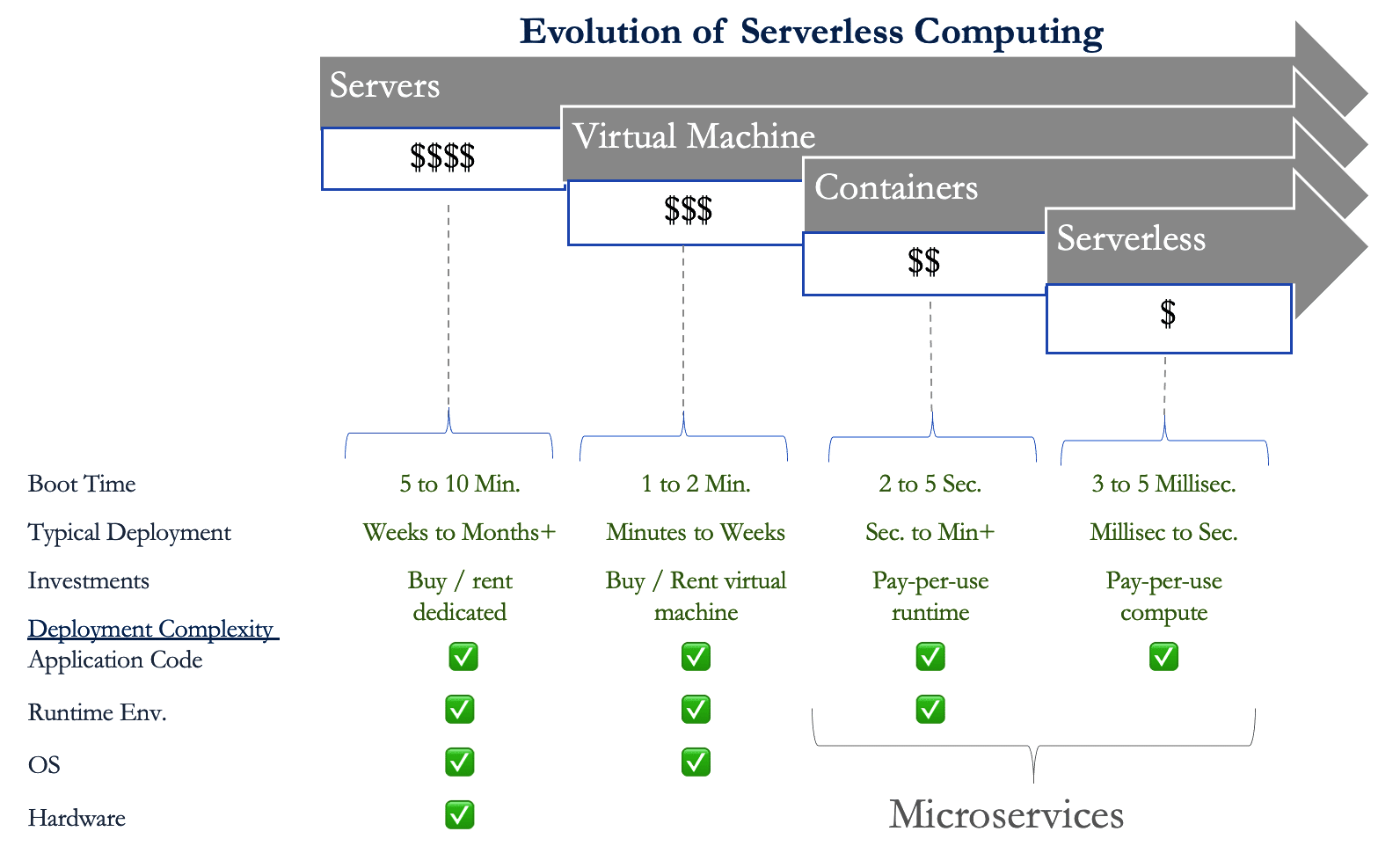Microservices architecture, containers and serverless computing are enabling businesses to build more resilient, scalable and efficient applications. Let’s see how these technologies became so popular and the benefits they offer.
Businesses need to embrace a variety of technologies as they transition to the digital age. Perhaps the most important among these is the migration to the cloud. Because the move to the cloud necessitates the creation of more adaptable and independently scalable programs, software engineers are progressively moving away from traditional, monolithic application architectures and towards microservices.
Microservices architecture is a method of software design that divides a large, complicated program into smaller, independent parts (microservices), each of which serves a distinct purpose and may be utilised by other applications. In the past, programmers have created programs with a monolithic design consisting of linked parts that must be changed or scaled simultaneously and executed sequentially. In a microservices software architecture, which divides complicated programs into separate parts, workloads continue moving to the cloud, where scalability is crucial. Containers and serverless software packages that can separate and house individual programs for more effective scalability, maintenance, and transfer between environments, have made this transformation possible.
Figure 1 depicts the history of modern application deployment over the past two decades, giving a glimpse of the breathtaking pace at which it has evolved.
As we can see in the figure, which shows the evolution of application design and deployment to serverless computing, the adoption of microservices-driven architecture has prevailed. The speed at which services can be booted at significantly low deployment complexity and cost in a pay-per-use model has been a game-changer for businesses. Let us take the example of Netflix and Uber — both industry leaders in their respective domains. They started with small investments in technology that enabled their rapid growth, and helped them displace other leaders. Both firms leveraged microservices-driven technology with containers and serverless computing.
Let’s look at containers and serverless computing in detail, with their pros, cons and best practices.
Containers
Containers are a type of virtualisation technology that allows you to run multiple isolated applications on the same operating system instance. They provide an efficient way to run applications in different environments, making them ideal for testing and development as well as production deployments. Containers provide a lightweight, easy-to-use alternative to traditional virtual machines. They are becoming increasingly popular due to their portability and flexibility, allowing developers to easily move applications from one environment to the next without worrying about compatibility issues. With containers, you can easily manage complex, multi-service applications in an isolated and consistent environment. Plus, they’re perfect for testing and development environments.

Serverless computing
Serverless is a cloud computing model where the cloud provider manages the infrastructure and automatically allocates resources as necessary. When using serverless, developers only need to worry about writing code, with the cloud provider handling everything else, including scaling, maintenance, and security. Serverless cloud technologies are best suited for event-based applications and services that don’t require persistent running instances. They are particularly useful for applications that need to scale quickly or experience unpredictable usage patterns. By unleashing the power of event-driven computing with serverless, you can encapsulate and scale your services without breaking a sweat. It’s the ideal choice for unpredictable usage patterns or applications that require ultra-fast response times.
Since both containers and serverless computing do not need to be associated with hardware or underlying operating systems, they do have some common benefits. Table 1 lists a few of these.
Cloud: The key trends
Let’s look at the key advancements in cloud technology as a result of the use of containers and serverless computing.
Software as a Service (SaaS)
SaaS is a cloud based software delivery model that provides access to applications over the internet. SaaS applications are typically subscription based and are hosted by the provider. It has a number of benefits, including:
| Containers | Serverless |
| Testing and development Containers provide a safe and isolated environment for developers to test and run code without impacting other projects or environments.Microservices Containers make it easy to separate application functionality into smaller components that can be scaled and deployed independently. Hybrid cloud environments Containers offer a consistent environment across different cloud providers and on-premise resources, making them ideal for hybrid cloud environments. |
Backend as a Service (BaaS) Serverless is ideal for building backend services, such as REST APIs, that require minimal configuration and can scale automatically.Event-driven apps Serverless is well-suited for applications that have specific events that drive their behaviour, such as chatbots or IoT devices. It has also become popular in tech modernisation. Batch processing Serverless is a great option for processing large amounts of data in batch, without having to worry about the underlying infrastructure. |
Speed: SaaS applications can be deployed quickly and easily.
Cost: These applications are typically more cost-effective than traditional on-premises applications.
Scalability: SaaS applications can be easily scaled up or down to meet demand.
Security: They are typically more secure than traditional on-premises applications.
Cloud portability
This is the ability to move applications and data from one cloud provider to another. Cloud portability is important because it allows organisations to avoid vendor lock-in. There are several factors to consider when evaluating cloud portability, including:
- The type of application: Some applications are more portable than others. For example, web applications are typically more portable than applications that rely on specific hardware or software.
- The cloud provider: Some cloud providers are more open than others. For example, Amazon Web Services (AWS) is more open than Microsoft Azure.
- The application’s dependencies: Some applications have dependencies on specific hardware or software. These dependencies can make it difficult to move the application to another cloud provider.
Composable applications
These applications are made up of smaller, independent components, which can be combined and recombined to create new applications. Composable applications have a number of benefits, including:
- Flexibility: Composable applications are more flexible than traditional monolithic applications. They can be easily adapted to meet changing needs.
- Agility: They are more agile than traditional monolithic applications, and can be quickly and easily developed and deployed.
- Scalability: These applications are more scalable than traditional monolithic applications. They can be easily scaled up or down to meet changes in demand.
Multi-cloud
This is a cloud computing strategy that uses multiple cloud providers. Its benefits include:
- Resiliency: Multi-cloud can help to improve resiliency by providing redundancy and avoiding single points of failure.
- Cost savings: It can help to reduce costs by allowing organisations to choose the best cloud provider for each application.
- Compliance: Multi-cloud can help to improve compliance by allowing organisations to use cloud providers that meet their specific compliance requirements.
Distributed anywhere
Distributed anywhere is a cloud computing strategy that distributes applications across multiple locations. Its benefits include:
- Performance: This strategy can improve performance by allowing applications to be closer to users.
- Reliability: It can improve reliability by providing redundancy and avoiding single points of failure.
- Security: Distributed anywhere can improve security by making it more difficult for attackers to target applications.
All the above trends in cloud computing are the result of advancements in containers and serverless offerings. These trends can help organisations to improve the agility, scalability, reliability, and security of their applications.

Containers and serverless cloud technologies both offer benefits for developing, deploying, and managing applications. While there are pros and cons to each, the decision of which to use ultimately comes down to the specific use case and requirements. Use containers when you have a complex application with multiple services that require a consistent and isolated environment. Containers are also ideal for testing and development environments. Use serverless when you have an event-driven application or service that requires encapsulation and scalability. Serverless is also ideal for applications with unpredictable usage patterns or a need for ultra-fast response times. By carefully considering your options and taking advantage of the strengths of each technology, you can build resilient, scalable, and efficient applications that meet the needs of your users and business goals.
This article expresses the view of the author and not of the organisation he works in.













































































